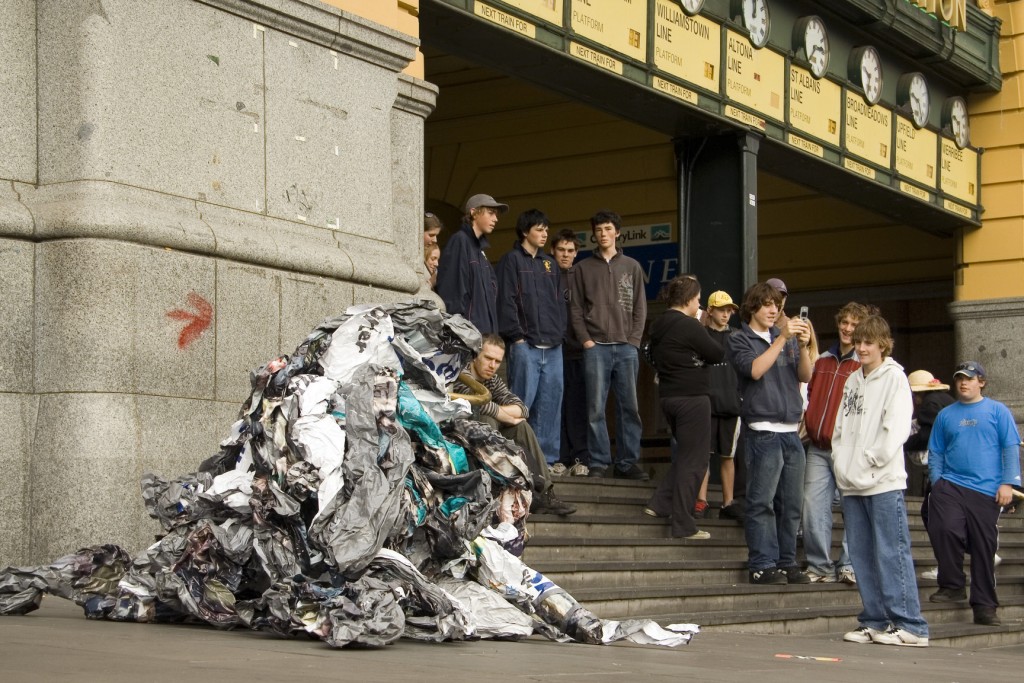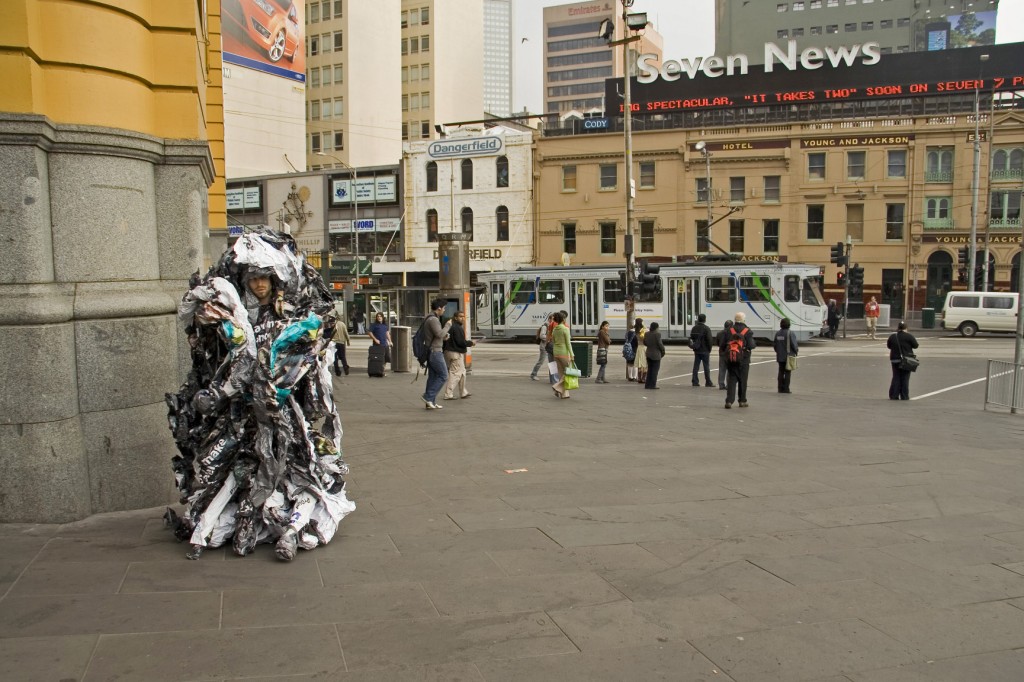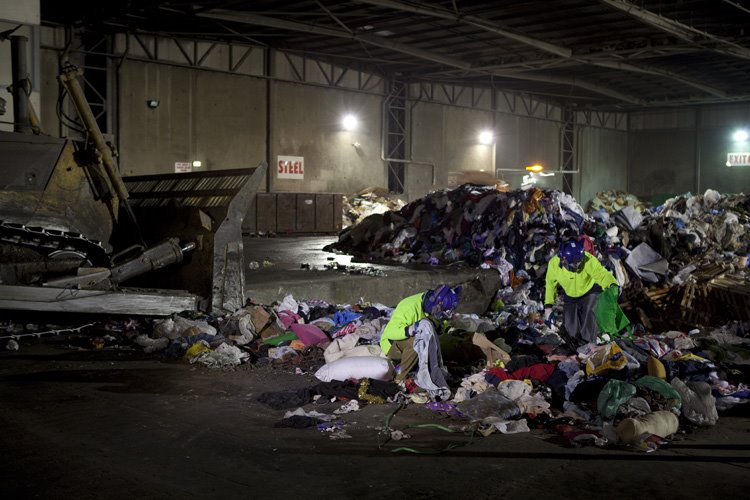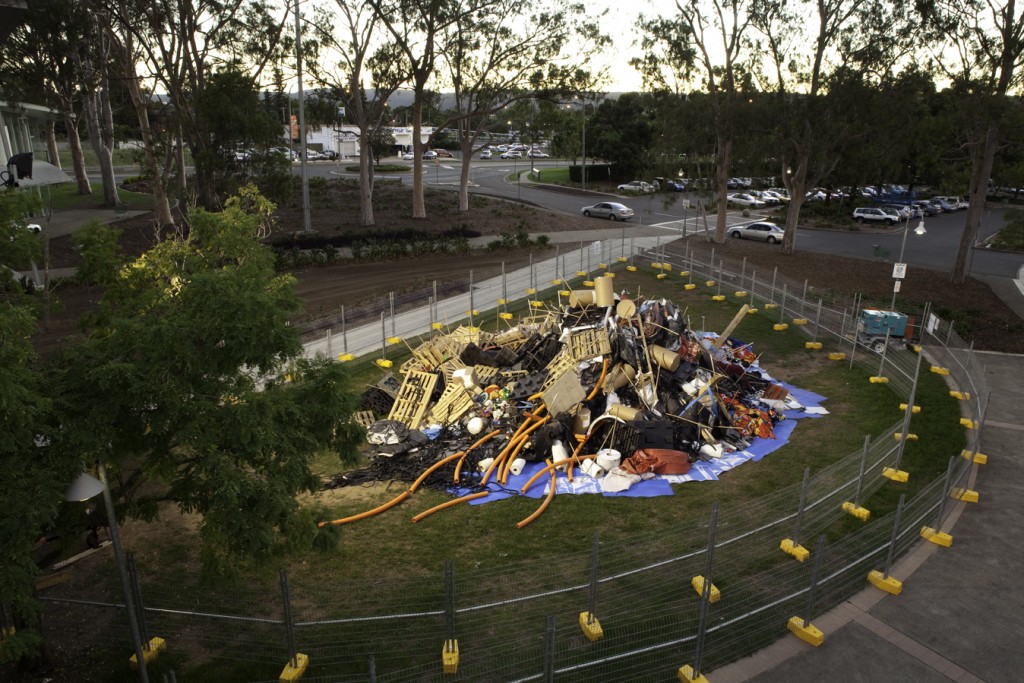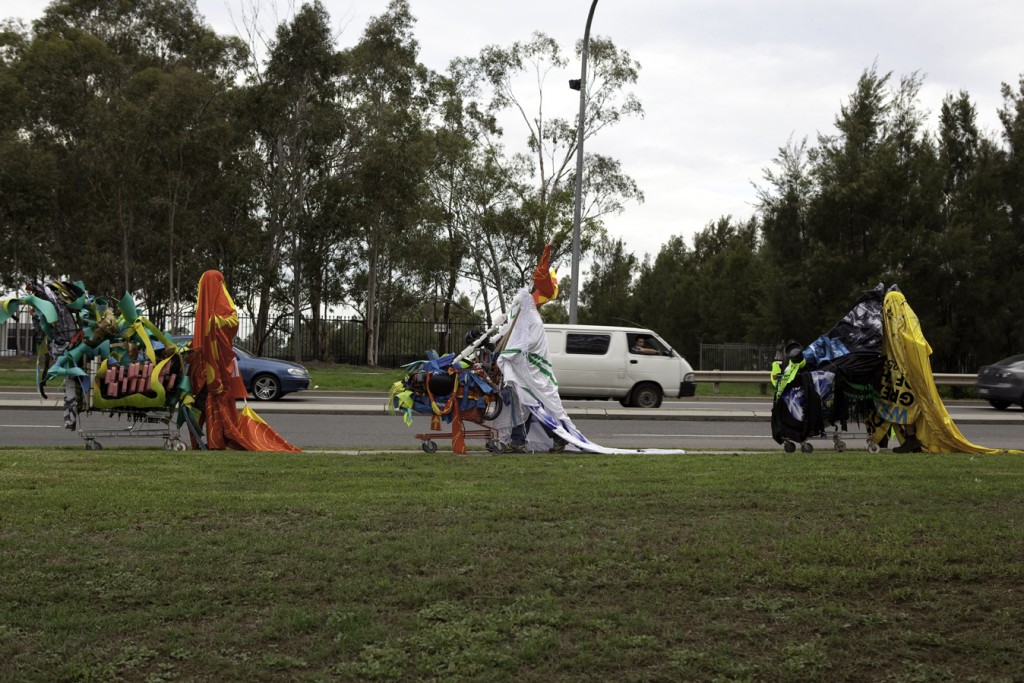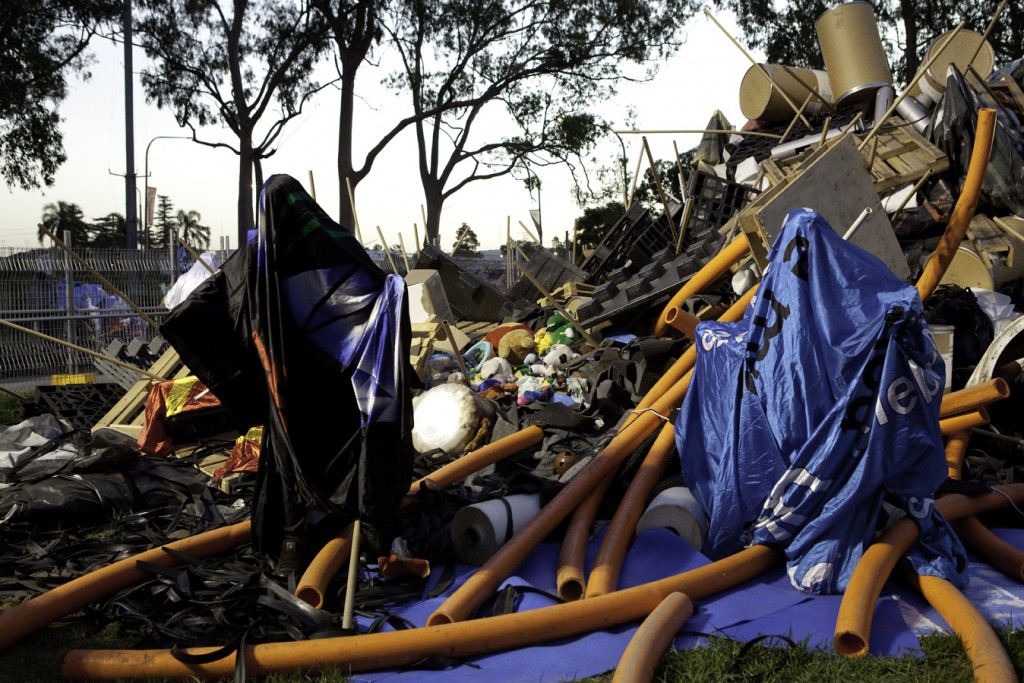By Verónica Tello and Laura Fisher
© all rights reserved. Printer friendly PDF version.
What contribution can public art make to public understandings of climate change? Posing such a question opens the door to well-traversed debates regarding the social role and political aesthetics of art, and specifically, art’s capacity to engage the public in pressing local and global crisis. But the concern here is not whether public art can generate any tangible outcomes or social benefits in relation to Anthropogenic crisis as has been the purview of some recent research in the field of socially engaged eco-art (Mar, Lally, Ang and Kelly). But rather how, within the context of current and immanent ecological crisis, art may catalyse critical, affective conceptions of climate change on the level of the imagination. To this end the imagination is not to be treated as something that mediates the interior of the mind and the exterior of the world but rather, as an affective force that underpins our relations with the world and the discourses through which we make meaning of our everyday lives (Yusoff and Gabrys). Adopting such an approach is critical to understanding what can be described as the futurist orientation of climate change, because, as Yusoff and Gabrys argue, ‘the imagination not only shapes the perception of climate change but co-fabricates it in ways that effect the possibilities to act upon it’ (520).
In this light, this essay is specifically concerned with the ways in which public art is in dialogue with political rhetoric and media imagery to shape imaginings of climate change. Thus, it takes into consideration the wider field of discourses that shape public perceptions, and proceeds from the premise that art does not have a monopoly on aesthetics, but is rather competing with forms of knowledge production and transmission in the public arena that also have aesthetic capacities. This means that it seeks to interrogate how anthropogenic crisis and its dominant narrative of climate change are given cultural meaning and communicated in the public arena, drawing upon both sociological and art theoretical understandings of the relationship between aesthetics and social change. It focuses on one specific public artwork, Activate 2750 (2009) [Figure 1], by the Australian artist Ash Keating, and one specific aspect of climate change politics that is central to this work: catastrophe and apocalypse. Ultimately it argues that through Keating’s fictionalisation of apocalypse, Activate 2750 offers the public an opportunity to engage with the figure of catastrophe in a manner that, however dystopian, is not constrained by the moral binaries which frequently circumscribe public discussions around the future implications of climate change.
Figure 1: Ash Keating, Activate 2750, 2009. Waste installation, Penrith City Cultural Precinct, Thursday 5th March 2009.
Commissioned by C3West with SITA Environmental Solutions. Photograph: Alex Kershaw, © the artist. Image courtesy of the artist.
Climate Change and the Public Imagination
The anticipation of catastrophe is a recurrent theme in public discourses around climate change. It is an idea that is formulated in a variety of ways across the spectrum of scientific, political, advocacy and journalistic forms of communication through which citizens come to understand the impact of not just the increase in global temperatures as a result of carbon emissions but also the repercussions of industrial-capitalist patterns of consumption (Yusoff; Hoggett; Swyngedouw). It thus draws into its orbit a range of fears around environmental and social change, including melting ice-caps and rising sea levels, extreme weather events, loss of biodiversity, water toxicity, and many other phenomena. The terrifying sense of momentum and inevitability that is generated by the concept of environmental catastrophe is partly attributable to the way scientists and advocates negotiate the protracted temporality and future orientation of the problem. In their efforts to persuade people of the urgent need to respond to a circumstance that does not yet shape their immediate experience, scientists and advocates provide predictions based on accelerating historical trajectories of transformation; and provide the public with facts and images about present forms of environmental change that are the consequence of past patterns of behaviour which cannot now be undone (Yusoff and Gabrys).
Images have played a key role in mediating the public’s imagination of ecological crisis. One early illustration, in an activist context, dates from the first years of Greenpeace’s campaign on the issue in the 1990s when it published Climate Time Bomb: Signs of Climate Change from the Greenpeace Database. The cover image represents a mirage like sphere that resembles both a setting sun and an atomic bomb mushroom cloud. In a less threatening manner, the image of the polar bear has recently been mobilised as a catalyst for raising climate awareness. As an icon of wild spaces that also invites sentimental engagement, the polar bear is now a potent signifier of species decline, melting ice and much else besides in international visual culture (Yusoff). Its magnetism as a means to make tangible the effect of rising sea temperatures illustrates the role played by popular aesthetics in determining how particular understandings of climate change gain purchase in the public imagination.
It is clear, however, that catastrophism has fomented responses that run counter to the objective of compelling people to take action. As Hoggett suggests in reference to both current climate change anxiety and previous eras in which apocalyptic thinking has entered the global social imaginary (such as the Cold War to which the Greenpeace cover image alluded), ‘catastrophism is intimately connected to despair’, an emotion that can counteract the very passion and sense of agency to which such discourses seek to appeal (271). He points out that this fatalism is made particularly acute due to the ‘totalizing vision’ of a vulnerable earth that is disseminated through climate change discourses (271). Similarly, Swyngedouw has suggested that ‘apocalyptic imaginaries’ of climate change futures are often ‘populist and foreclose a proper political framing’ (219). This is because they picture an undifferentiated field of crisis, rather than one in which the specific social, economic and environmental effects of capitalist systems can be reckoned with in concrete terms.
The ambivalent effects of assertions about the catastrophic effects of climate change in the public domain are of course also attributable to the fact that they are explicitly entangled with discourses of morality. As Al Gore declared in his much quoted acceptance speech following his receipt of an Academy Award for An Inconvenient Truth, ‘[climate change] is not a political issue; it’s a moral issue. We have everything we need to get started, with the possible exception of the will to act. That’s a renewable resource. Let’s renew it’ (in Nagourney). Similarly, by calling one of his most recent books on the issue Here on Earth: A New Beginning (2010), the Australian scientist and climate change action advocate Tim Flannery exemplifies the redemptive inflection of many variations of climate change discourses (Hoggett, Wilson).
The discourse of catastrophe, and its configuration as morally implicating to the individual, has naturally made it a target of those discourses that dispute anthropogenic climate change. In Australia, this denial has been consecrated at the apex of the political system, having fuelled the strange series of events that led from the bipartisan negotiation of an Emissions Trading Scheme with then Prime Minister Kevin Rudd and opposition leader Malcolm Turnbull in 2009, to the regressive policy landscape of the Abbott government (2013-15). During this period particularly, climate change catastrophism invited the allegation that scientists were extremists, zealots and crusaders (see for example Howard; Lloyd; Griffiths; Manne). These discourses frequently appropriate the trope of catastrophe to their own cause, broadcasting inverted images of disaster in the service of neoliberal opposition to policy action designed to reduce carbon emissions. As Abbott stated (as opposition leader) when he visited the steelworks in the South Australian town of Wyalla during the 2013 election campaign: ‘Whyalla will be wiped off the map by Julia Gillard’s carbon tax, Whyalla risks becoming a ghost town, an economic wasteland if this carbon tax goes ahead’ (Pedler, authors’ emphasis. For other examples see Wilkinson, Cubby and Duxfield; Manne: 44, 49).
Abbott’s discourses gain their populist efficacy through their vernacular, concise and hyperbolic character, and their performative context—hard-hat and yellow vest among the workers. This form of communication requires ‘minimal knowledge brokerage’ and plays on the ‘simple binaries of danger/safety, punishment/reward and complicated/simple’ (Eckersley 392). Jeffrey Alexander theorises symbolic modes of communication proliferated in everyday discourse, through the media and political rhetoric, that characterise discourses of climate change. He points out that citizens daily encounter a variety of modes of performance, narrative, and symbolic and rhetorical forms of communication. Embedded within these forms are myths, metaphors and icons, all of which trigger a sense of affinity or aversion. As he points out, these idiomatic forms operate as symbolic codes which circumscribe the space of civic virtue and legitimacy in society, a circumscription that is realised through a variety of dichotomies: worthy or unworthy, rational or irrational, pure and polluting, and so on.
The persistence of conflict between these forms rests on the fact that no community has a permanent monopoly over the virtuous pole. As Alexander points out ‘What is contested in the course of civic life … is how the antithetical sides of the discourse, its two symbolic sets, will be applied to particular actors and groups’ (64).[1] This pattern of contestation is precisely what is at play in the conflict over climate change discussed above, and the mobilisation of visions of catastrophe by those who advocate for and against action on climate change. On the one hand, environmentalists and climate scientists point to scientific facts as the rational foundation of an imperative to act, and frame their arguments for the urgency of this imperative within appeals to consciences and willpower. On the other, climate change deniers characterise scientists and advocates as irrational and zealous and accuse them of making exaggerated claims that will encourage anti-democratic restrictions on liberty. Alexander’s theorisation makes clear just why politics, as it is conducted in the public sphere, is often very far from rational decision-making and reasoned discourse. But it is nonetheless highly dichotomous—playing on the binaries of good and bad—and limited by the conventions and realities of consensus driven democracy.
Fictionalising: The Aesthetics of Climate Change and Public Art
With these brief remarks on way the idea of environmental catastrophe is configured in the public domain in mind, it is now worth returning to the question of what role art, public art in particular, might play in fostering an engagement with the inevitability of major environmental and social transformation on the level of the imagination. Numerous scholars have argued for the capacity of art to act as a powerful affective agent within the context of political events and social movements (Bennett; Papastergiadis; Demos). For example, philosophers such as Jacques Rancière argue for the role of aesthetics—a poetic and affective force and sensory experience—as a means to disrupt the ‘distribution of the sensible’ (what is possible to feel, do, see, and say). For such thinkers, aesthetics is more than capable of instituting a space that resists and complicates (for example) the rhetoric of politicians and mass media communication. However, as Rancière suggests, aesthetics is only a proper political art form if it disrupts the conventional expectations of political art (didacticism, moralising etc.), and leaves room for ‘free play’. This is an aesthetic experience that moves the spectator to dissociate themselves from the given reality, and shift between one space/time continuum and another; between the aesthetics of art and the aesthetics of political rhetoric, enabling a different (complex) subjectivity and view of the world than is otherwise available.
This reading of the politics of aesthetics has become central to understanding how artists are able to engage global crisis. The challenges of global crisis, including climate change, would seem to demand from contemporary artists strategies that directly address the failures and omissions of the mass media and political rhetoric, adopting methods of exposé for example. Yet, many contemporary artists have instead privileged sensory, poetic and affective forms of communication that cut across the binaries of fact and fiction, offering highly speculative yet still convincing readings of the world (Tello; Demos 10). These practices, which can be described as practices of fictionalisation, have the capacity to breach the morally inflected dichotomies that frame adversarial public discourse. This is because, as Rancière suggests, fictionalising ‘does not mean telling stories, it means constructing another sense of reality, another set of connections between spaces and times, between words and visual forms, spoken word and written words, between a here and an elsewhere, and a now and a then’ (Rancière). Fictionalisation offers a means to reformulate existing discourse and establish a field for new narratives that diverge from the continuum of the ‘sensible’ (what is given). Rancière elaborates:
Critical art must negotiate the tension that pushes art towards ‘life’ and which, conversely, separates aesthetic sensoriality from other forms of sensible experience. It must borrow the connections that provoke political intelligibility from the blurry zone between art and other spheres. And it must borrow the sense of sensible heterogeneity that feeds the political energies of refusal from the isolation of the work of art. It’s this negotiation between the form of art and thus of non-art that permits the formation of combinations of elements capable of speaking twice: from their readability and from their unreadability. (84)
This is how artists who work ‘between art and other spheres’, instantiate a different kind of imaginary into the public arena. Such artists effectively conjure evocative and provocative fictions which allow the public to imagine and speculate, which leave room for ambiguity and uncertainty, and which question and negotiate ‘reality’. ‘Fictionalising’, in other words, is an aesthetic practice that produces narratives and images of urgent social and political phenomena that are in conflict with the rhetoric and visualisations of politicians and the mass media. It is in this light that Keating’s Activate 2750 can be seen to be an exemplary public artwork, especially since it directly addresses idea of apocalypse and catastrophe in relation to the Anthropocene. Before elaborating on how Activate generates a fictionalisation of the apocalyptic dimensions of climate change—as a means to contest, in a poetic and forceful manner, the discourse and aesthetics of climate change denial—some background to Keating’s practice is necessary.
Activate 2750
Figures 2-3: Ash Keating, Support Can Make the Difference, 2006. Photograph: Andrew Noble. Image courtesy of the artist and Fehily Contemporary
Keating’s practice is very much affiliated with the concerns of ecologist groups in Australia and elsewhere that have focused on environmental issues that arise in advanced industrialised societies. Keating’s mother, Pam Keating, was a prominent figure in the Australian environment movement, and in 2002 the artist began working for her waste audit and consultancy company. Here he was responsible for visually assessing the amount of commercial and industrial waste sent to landfill. ‘This experience’, explains Keating, ‘opened my eyes to the disregard that industry in general has for sustainability’ (Keating). In subsequent years, his practice began to echo themes explored in the emergent field of waste studies, in which landfill is investigated as a repository of society’s discarded objects; and a space for critical and creative practice that allows us to re-think human/non-human relations to waste (Reno). Between 2005 and 2007, for example, Keating undertook a series of performances that involved embedding himself in piles of discarded vinyl billboard posters (drawn from the debris of the 2006 Commonwealth Games) [Figure 2, Figure 3], appearing like a ‘waste creature’ to unsuspecting crowds in Melbourne’s Central Business District (Gardner 45). Other works which engaged with waste as a sculptural and performative medium followed in May and August 2008 with 2020? [Figure 4] and Label Land. Here, the artist worked with SITA Environmental Solutions to construct an enormous monument to consumer waste in Melbourne’s Meat Market and a series of public performances in Seoul’s shopping district using the discards of clothing manufacturers, respectively.
Figure 4: Ash Keating, 2020?, 2008. Photo: Ash Keating. Image courtesy of the artist.
Following these projects, in October 2008, the C3West program (hosted by the Museum of Contemporary Art, Australia) invited Keating—and a range of other contemporary artists—to submit a competitive proposal for a project that could address unsustainable waste practices in Penrith. The project would involve the artist working in collaboration with SITA Environmental Solutions. SITA manages three waste management sites in Western Sydney and wanted to work with C3West in order to raise awareness about its work in the local community. Such collaborations are increasingly common as a means to generate ‘visibility’ for waste management solutions and to simultaneously democratise this process—artists and visual culture are of course seen to play a vital role in such ‘visualisation’ (Bennett, Miles).
To prepare his proposal for C3West, Keating travelled to Penrith—postcode 2750—numerous times throughout November 2008. He concluded that like many other suburbs, ‘Penrith is a consumption Mecca swamped by superstore complexes and an enormous shopping plaza. The centre of the city is marked by the Penrith City Council, the Joan Sutherland Performing Arts Centre and the Westfield shopping centre’ (Keating). He envisaged that he could ‘activate’ these key public spaces and commercial areas by bringing them into closer proximity with the area’s waste and landfill that is usually located out of sight and mind at the SITA landfill in Kemps Creek.
In turn, Keating organised three SITA trucks from the Davis Road Transfer to dump a selection of waste in the front lawn of the Joan Sutherland Performing Arts Centre, a prominent part of Penrith’s city centre [Figure 5]. The waste had been selected and intercepted by Keating and his assistant Rus Kitchin over a period of two weeks: every day at three in the morning they travelled to the Transfer Station, accumulating 52 square meters of waste to be used for Activate 2750. The materials used included wooden pallets, fabric, cardboard, timber, hard plastics, rolls of paper and rubber belting (amongst other waste). By making this selection, Keating intended to underline how that which is often deemed ‘waste’ is in fact often recyclable and usable material. As two tradesmen commented with regard to the materials used in Activate 2750: ‘We could reuse just about everything in there’ (Mar, Lally, Ang and Kelly 42).
Figure 5: Ash Keating, Activate 2750, 2009. Transformers intercepting waste material. 4-7am Friday 20th February, 2009.
Commissioned by C3West with SITA Environmental Solutions. Photograph: Alex Kershaw, © the artist. Image courtesy of the artist.
Art and Waste
Keating’s practice can be seen as emerging out of a long genealogy of art concerned with the aesthetics and politics of waste. This genealogy spans the avant-gardist practices of the Dadaists, Surrealists and Arte Povera and is characterised by a consistent focus on mining the ephemera and discards of modern industrialisation. Artists in this aesthetic tradition recalibrate, recode and reanimate waste to find new values and meanings in the material that is pushed to the margins of the mainstream (Whiteley 11-30). Such a genealogy can also be seen to include neo-avantgarde, post-war practices such as Allan Kaprow’s New-York-based Happenings. In Yard (1961) Kaprow created an environment from used car tires, inviting the public to play with the discards of a hyper-consumerist society (similar strategies and affects were generated by Claes Oldenburg’s The Store, 1961-2). In the same era, a wave of artists residing in the San Francisco Bay Area began to work with waste, developing a distinct aesthetics of recycling which was very much informed by the environmental policies and programs being developed by the city at the time (Whiteley 59). In these contexts artists would offer ‘gifts’ to the public in the form of usable waste, for example by leaving discarded but functional second hand electrical goods on the sidewalk. An awareness of the politics of waste—which emerged out of the American post-war consumerism boom—and the necessity to produce new models of exchange and everyday practices is also seen in Mierle Laderman Ukeles Touch Sanitation (1978-80). Fundamental to Touch Sanitation is the imperative of caring for and maintaining the city in order to develop a sustainable urban ecosystem, while the work also addressed the need to shift public attitudes towards garbage and those who work with it, namely, garbage collectors (Conte).
Certainly, a work such as Activate 2750 can be seen to be part of this trajectory of waste-focused art practice. Like Ukeles’ Touch Sanitation, it attempts to engage the public and challenge conventional notions of waste, all the while critiquing modes of consumption common in industrialised societies (as found in Kaprows’ Happenings, for example). It does so with the kind of eco-consciousness that has its roots in the environmentally aware practices of artists from the San Francisco Bay Area (like Bruce Conner); but it also necessarily positions itself in its proper historical moment: it is contemporaneous with the specific discourse of climate change and a wave of projects that take as their theme the dialectics of anthropogenic crisis and the relentless advent of industrialisation (Miles).
In this sense, it is no surprise that critics of Keating’s work, including Activate 2750, have predominantly focused on the artist’s commitment to ecological and environmental concerns and his desire to raise awareness about the high levels of capitalist consumption in Australian suburbs and cities (Moncrieff; Mar, Lally, Ang and Kelly). As Keating himself has stated ‘everyone is implicated, including myself, in being part of this type of society … Being able to bring this project [Activate 2750] to Sydney’s west is a way for me to be able to open up a dialogue about the way in which we live’ (Keating).
Art, Waste and Apocalypse
While raising awareness is certainly one function of Keating’s work, as Amelia Barikin argues, Keating’s work is most interesting because of its subtle thematisations of the experience of loss (20), and more precisely, loss in the era of the Anthropocene: being at the end of time. It is significant, for example, that the series of inter-related works Activate 2750, 2020? and Label Land were developed in the years immediately following the release of Al Gore’s An Inconvenient Truth (2006) when the discourses around environmental catastrophe were intensifying globally. In Australia, for example, the Garnaut Review reports in 2008 underlined the vulnerability of Australia to the effects of global warming. The impacts of the heightened public consciousness of the idea that environmental catastrophe was imminent would inevitably come to shape the artist’s practice. For his more recent work, Gardensity, commissioned as part of the 2011 Scape Public Art Biennial in Christchurch following the city’s devastating earthquake, Keating became attuned to parallel emergencies around the world: the Icelandic volcano, the Japanese earthquake and the Fukushima nuclear disaster. He states that in the midst of these events, ‘I started looking into prophecies around the end of the world, December 21, 2012’ (Barikin 21).
The Fiction of Aftermath
Figure 6: Keating, Activate 2750. Waste pile, Penrith City Cultural Precinct, Wednesday 4th March 2009.
Commissioned by C3West with SITA Environmental Solutions. Photograph: Alex Kershaw, © the artist. Image courtesy of the artist.
Figure 7: Keating, Activate 2750. Procession 1 – Mulgoa Road Superstore District, Penrith, Tuesday 3rd March, 2009.
Commissioned by C3West with SITA Environmental Solutions. Photograph: Alex Kershaw, © the artist. Image courtesy of the artist.
Activate 2750 offers a means to imagine, live with and, more to the point, fictionalise the chaotic and unpredictable forms of life that will emerge as a consequence of climate change inaction [Figure 6]. As part of this artwork, the public would have witnessed, for example, Keating and collaborating performers draped in large colourful commercial banners walking through the Western Sydney suburb of Penrith and its commercial road, eventually entering into Westfield Shopping Centre [Figure 7]. They soon enter the suburban plaza—multiple levels of chain stores (Big W, Franklins, Myer, Target and Woolworths and Hoyts cinema)—pushing shopping trolleys—or ‘waste sculptures’—brimming with commercial detritus, strangely reconfigured for a world unknown. Keating and collaborators traverse the vast spaces of Westfield’s hallways and food courts, and move up and down its escalators, in militaristic uniform lines [Figure 8].
Figure 8: Keating, Activate 2750. Procession 3 – Westfield Penrith Shopping Centre, Penrith, 4:00-6:00pm Thursday 5th March, 2009.
Commissioned by C3West with SITA Environmental Solutions. Photograph: Alex Kershaw, © the artist. Image courtesy of the artist.
Leaving Westfield, the creatures soon re-enter the streets of Penrith and return to what appears to be their home or site of worship: a monument to waste contained by fencing that, in Keating’s words, comprises ‘an apocalyptic zoological habitat’. Its arrangement was in some ways responsive to the fact that Keating had been advised by council that the pile of waste would need to be ‘contained’ by a fence for safety reasons, a decision that is illustrative of Mary Douglas’ argument that we are threatened by those objects which have been absorbed into the category of ‘waste’ (160). Keating decided to capitalise on the cultural meaning communicated by this demarcation and placed a second fence within the contained area to create a rat run. Outside the fencing, we see the zombie-like figures—performed by Keating alongside local choreographers and artists—silently standing in line, before entering the hazardous site one at a time in ceremonial procession. They soon begin to surround the installation in a large circle, performing a series of repetitive movements that reflect the sounds of machinery and mechanical glitches, before kneeling down to rest by the mountain of waste as night begins to fall [Figure 9]. Through their strange vitality we recognise that, far from presaging the suffocation of life by waste, or imagining the elimination or useful repurposing of waste, Activate 2750 imagines waste as resilient and abundant. This waste has in fact spawned a new kind of synthetic, parasitic life that is in keeping with the models of biodiversity that we can come to anticipate in future climates (Yusoff). In this sense, Activate 2750 generates a fictionalisation of not only ecological catastrophe, but an evolution of life at the end of the Anthropocene. Keating’s work elicits the sense of being engulfed by waste that is not only frighteningly voluminous—a kind of post-consumerist sublime—but is also generative of something non-human, it inhabits both the concerns of the present and the future—of what we are and what we might become.
Figure 9: Keating, Activate 2750. Final Procession – Penrith City Cultural Precinct, Friday 6th March.
Commissioned by C3West with SITA Environmental Solutions. Photograph: Alex Kershaw, © the artist. Image courtesy of the artist.
* * *
Activate 2750 confronts citizens with the dissonance of a political art through its many-faceted fictionalisations of apocalypse, offering another way of imagining what the future may (and may not) hold. While its many elements have terrific affective and imaginative force, there are no appeals to notions of virtue or reason, no morally inflected allusions to catastrophe. The convergence of seemingly absurd artistic performances, scenarios and installations within Australian suburbia infects the continuum of everyday life and provokes forms of intelligibility and experience which intermingle with and challenge homogenising and reductive readings of climate change, as propagated through opinion polls, sound bites and moralistic political campaigns. It fictionalises our world and its complex aesthetics and discourses, to proffer one vision of the future where we are as much at the ‘end of time’ as we are ‘out of time’.
In this sense, the significance of Keating’s work rests not only in its capacity to mediate and critically intervene in public imaginations of climate change including as they are shaped by the mass media and political rhetoric; or its engagement with the aesthetics of apocalypse in a playful and poetic form distinguishing it from the moralistic campaigns of many climate change activists. Keating’s Activate 2750 also, in fact, represents an emergent though still largely undertheorised paradigm of eco-public art. It shares a critical affinity with a handful of artworks, such as the Yes Men’s Survivalball (2006), which have attempted to grapple with visualisations and aesthetics of anthropogenic apocalypse, distinguishing themselves from the kinds of projects that dominate this field. The global phenomenon of Park(ing) Day, for example, is an annual event that, since 2008, has mobilised thousands of people to create temporary ‘parks’ in car parking spaces in high-density areas as a means of contesting the erosion of ‘green’ spaces in cities (for more examples see Curating Cities). The socially inclusive and optimistic orientation of such projects register, at least in part, an effort by artists and art-commissioning bodies to counteract the negative political and populist perspectives that have such currency in the public domain. Even though the artist locates his work in that context himself (Keating), we argue that the aesthetics of Activate 2750 do something else: like artists before him, such as Kaprow and Ukeles, Keating’s work offers a creative-criticality toward waste pertinent to his time and political context. If this is no longer focused on explicitly mobilising the affective notions of ‘sustainability’ in industrialist societies or the ‘care’ of ecologies but, rather, on imagining the aftermath of the Anthropocene, then it is because new strategies are needed to effectively mediate perceptions and ways to inhabit a precarious present and future.
Verónica Tello is Vice-Chancellors Postdoctoral Research Fellow at the National Institute for Experimental Arts, University of New South Wales, Australia. Her research broadly focuses on biopolitics, necropolitics and critical border studies. Her new book is entitled Counter-Memorial Aesthetics: Contemporary Art and Refugee Histories (Radical Aesthetics-Radical Art series, Bloomsbury, 2016).
Laura Fisher is Postdoctoral Research Fellow at the Sydney College of Arts, University of Sydney. Her recently published book is titled, Aboriginal Art and Australian Society: Hope and Disenchantment (Anthem Press, 2016). Her current research examines art projects in rural communities in Australia, Sweden, Japan and Russia that are facing challenges such as land-use conflict, depopulation and environmental crises.
Notes
[1] This is clearly illustrated by the universal appreciation of the dystopian vision of George Orwell’s Nineteen Eighty-Four (1949): conservatives saw it to be a representation of the apparatus of communism, while other groups recognised it as a critique of the anti-democratic institutions of capitalism (Alexander 63-4).
Works Cited
Adorno, Theodor W. ‘Cultural Criticism and Society.’ Culture and Mass Culture. Ed. Peter Davidson, Rolf Meyersohn and Edward Shils. Cambridge: Chadwyck-Healey Ltd, 1978. 105-22.
Alexander, Jeffrey. The Civil Sphere. Oxford: Oxford UP, 2006.
—. ‘Cultural Pragmatics: Social Performance Between Ritual and Strategy’ Sociological Theory, 22.4 (2004): 527-73.
Barikin, Amelia. ‘Time Shrines: Melancholia and Mourning in the Work of Ash Keating.’ Discipline 2 (2012): 18-24.
Bennett, Jill. Practical Aesthetics: Events, Affects and Art after 9/11. London: I. B. Tauris, 2012.
—. Living in the Anthropocene. Documenta 13: 100 Notizen – 100 Gedanken, 053. Ostfildern: Hatje Cantz, 2011.
Conte, Karl, ed. Mierle Laderman Ukeles: Seven Work Ballets. Berlin: Sternberg, 2014.
Curating Cities Database of Eco-Public Art. 2013–. <http://eco-publicart.org>.
Demos, T. J. ‘Moving Images of Globalization.’ Grey Room 37 (2009): 6-29.
Douglas, Mary. Purity and Danger: An Analysis of the Concepts of Pollution and Taboo. London: Routledge, 1966.
Doyle, Julie. ‘Picturing the Clima(c)tic: Greenpeace and the Representational Politics of Climate Change Communication.’ Science as Culture 16. 2 (2007): 129-50.
Eckersley, Robyn. ‘Poles Apart?: The Social Construction of Responsibility for Climate Change in Australia and Norway’ Australian Journal of Politics and History 59.3 (2013): 382-96.
Gardner, Anthony. ‘Taking Care of Business: Ash Keating.’ Artlink 27.4 (2007): 44-5.
Griffiths, Tom. ‘Weather and Mind Games: Why can’t we talk about climate change?’ Griffith Review 41 (2013): 246-65.
Hoggett, Paul. ‘Climate change and the apocalyptic imagination.’ Psychoanalysis, Culture & Society 16.3 (2011): 261-75.
Howard, John. One Religion is Enough. Annual GWPF Lecture, The Institution of Mechanical Engineers, 5 November 2013. London: The Global Warming Policy Foundation, 2013. <http://www.thegwpf.org/john-howard-religion>. 30 Mar. 2014.
Keating, Ash. ‘Activate 2750—explanation of the project by artist Ash Keating.’ Activate 2750, 30 April 2009. <http://activate-2750.blogspot.com.au>. 30 Mar. 2014.
Lloyd, Graham. ‘Climate policies helped kill manufacturing, says Maurice Newman.’ The Australian 31 December 2013. <http://www.
theaustralian.com.au/national-affairs/policy/climate-policies-helped-kill-manufacturing-says-maurice-newman/story-e6frg6xf-1226792218812#>. 4 Apr. 2014.
Manne, Robert. Bad News: Murdoch’s Australian and the Shaping of the Nation Quarterly Essay 43. Collingwood, Vic.: Black Inc, 2003.
Mar, Phillip, Elaine Lally, Ien Ang and Michelle Kelly. ‘The Artists and their Projects: Ash Keating, Activate 2750.’ The Art of Engagement: Culture, Collaboration, Innovation. Ed. Kay Anderson, Ien Ang and Elaine Lally. Crawley, Western Australia: UWA Publishing, 2011. 39-48.
Miles, Malcolm. ‘Representing Nature: Art and climate change.’ Cultural Geographies 17.1 (2010): 19-35.
Moncrieff, Abigail. ‘Mess We Create: Interview with Ash Keating and Rus Kitchin.’ Activate 2750. Sydney: Museum of Contemporary Art, 2009. 9.
Nagourney, Adam. ‘Gore Wins Hollywood in a Landslide.’ The Caucus, The New York Times, 27 February 2007. <http://thecaucus.blogs.nytimes.com/2007/02/25/gore-wins-hollywood-in-a-landslide/>. 9 Jun. 2015.
Papastergiadis, Nikos. Cosmopolitanism and Culture. Cambridge: Polity Press, 2012.
Pedler, Emma. ‘Tony Abbott visits Whyalla, speaks against proposed mining and carbon taxes.’ ABC Eyre Peninsula, 27 April 2011. <http://www.abc.net.au/local/stories/2011/04/27/3201383.htm>. 25 Jun. 2015.
Rancière, Jacques. ‘The Aesthetic Revolution and Its Outcomes.’ New Left Review 14 (2002): np.
—. The Politics of Aesthetics: The Distribution of the Sensible. London: Continuum, 2006.
—. ‘Problems and Transformations in Critical Art (2004).’ Participation. Ed. Claire Bishop. London: Whitechapel Gallery and MIT Press, 2006. 83-95.
—. ‘What Makes Images Unacceptable?’ Paper presented at Pacific North West College of the Arts, Portland, Oregon, February 29, 2008. QuickTime file. <http://homeroom.pnca.edu/inline/46842.mov>.
Reno, Joshua Ozias. ‘Toward a New Theory of Waste: From “Matter out of Place” to Signs of Life.’ Theory Culture & Society 31.6 (2014): 3-27
Swyngedouw, Erik. ‘Apocalypse Forever? Post-political Populism and the Spectre of Climate Change.’ Theory, Culture & Society 27.2-3 (2010): 213-32.
Tello, Veronica. ‘Activate 2750: Ash Keating.’ Curating Cities: Database of Eco-Sustainable Public Art. 2013. <http://eco-publicart.org/activate-2750>. 25 May 2015.
—. ‘Counter-Memory, Heterochronia and “History Painting” (After Géricault): Dierk Schmidt’s SIEV-X—On a Case of Intensified Refugee Politics.’ Contemporaneity: Historical Presence in Visual Culture 4 (2014): np.
Tranter, Bruce. ‘Political divisions over climate change and environmental issues in Australia’ Environmental Politics 20.1 (2011): 78-96.
Whiteley, Gillian. Junk: Art and the Politics of Trash. London: I. B. Tauris, 2011.
Wilkinson, Marian, Ben Cubby and Flint Duxfield. ‘Come in spinner.’ The Sydney Morning Herald 7 November 2009. <http://www.smh.com.au/environment/come-in-spinner-20091106-i261.html>. 10 Oct. 2014.
Wilson, Erin K. ‘Religion and Climate Change: The politics of hope and fear.’ Local-Global 10 (2012): 20-9.
Yusoff, Kathryn. ‘Biopolitical Economies and the Political Aesthetics of Climate Change.’ Theory Culture & Society 27.2-3 (2010): 73-99.
Yusoff, Kathryn, and Jennifer Gabrys. ‘Climate change and the imagination’, Wiley Interdisciplinary Reviews: Climate Change 2.4 (2011): 516-34.

